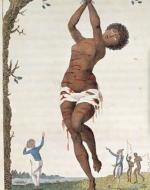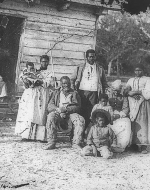Created by Iris Betancourt on Sat, 04/13/2024 - 21:36
Description:
INTRODUCTION
The institution of slavery in the United States stands as a clear reminder of a period when human dignity was compromised. It denied human rights and freedom to millions of African Americans that were defined by violence and dehumanization. The endurance of this institution, persisting from the early colonial days until its abolition in 1865 showcases the resilience and resistance of the enslaved.
Poets and writers often took up a pen to speak out against the injustices of slavery. Elizabeth Barret Browning's, “The Runaway Slave at Pilgrim’s Point (1848)” dives into the soul of a fugitive slave woman. The poem sheds light to enslaved individuals who were denied independence in the United States. “I have run through the night, my skin is as dark,I bend my knee down on this mark: I look on the sky and the sea” (Browning, line 5-7). Browning’s words paint an agonizing picture of the woman's distress. Through this powerful text, Browning is able to capture the immense pain and irony of a slave seeking liberty and a voice in the vast expanse of the world around them.
Kevin Bales, in his article, “Expendable People: Slavery in the Age of Globalization” comments that the form of slavery still continues to exist but these individuals are “No longer seen as property, people today are seen merely as disposable inputs into production.” (1). Comparing historical slavery to modern forms of slavery is vital because it helps us understand the transformation of oppressive systems while also honoring the experiences and struggles of those who were enslaved. It provides a foundation for addressing the racial and economic disparities that exist today, many of which can be traced back to the institution of slavery. In what ways have the voices and experiences of enslaved individuals been acknowledged in historical narratives?
The following images in this gallery explore the question asked and highlights the way slavery was depicted in America. It also helps connect with the powerful poem by Elizabeth Barret Browning. Every image chosen in my gallery tends to showcase the abuse and dehumanzation treatment that enslaved people experienced. It is to put a spotlight on the voices that were overlooked in the past.
Works Cited
Bales, Kevin. “Expendable People: Slavery in the Age of Globalization.” Journal of International Affairs, vol. 53, no. 2, 2000, pp. 461–84. JSTOR, http://www.jstor.org/stable/24357761.
Images in the Series
Fig. 1. Flagellation of a Female Samboe Slave, 1793. William Blake after John Gabriel Stedman. Stedman's "Narrative, of a Five Years' Expedition" http://l-adam-mekler.com/ebbrowning.htm : https://www.nga.gov/collection/art-object-page.4991.html
Stedman was a Dutch-born Scottish soldier who wrote “The Narrative of a Five Years Expedition against the revolted Negroes of Surinam” which is an autobiographical account of Stedman’s experiences. One Stedman’s observations involves torture of a nearly naked enslaved woman. Stedman describes many other stories regarding the dehumanization treatment that these slaves were subjected to. When searching for images that connected to Elizabeth Barret Browning’s, “The Runaway Slave at Pilgrim’s Point (1848)”, this image was one of the few that stood out. It really ties in with some of Browning’s experiences, “Our countless wounds that pay no debt” (Browning, line 238), Emphasizing that the suffering of these wounds remain unacknowledged and uncompensated in any meaningful way. It really exemplifies the dark, dehumanizing and brutal reality of the conditions endured by enslaved individuals. It not only serves to showcase the past horrors but also calls to action by recognizing the enduring scars of these chained souls.
Fig. 2. Five generations on Smith's Plantation, Beaufort, South Carolina
Creator(s): O'Sullivan, Timothy H., 1840-1882, photographer. This photo of five generations of an enslaved family living on Smith's Plantation in Beaufort, South Carolina, was taken in 1862. https://www.loc.gov/pictures/item/98504449/ : https://historymatters.gmu.edu/d/6807/ : https://www.getty.edu/art/collection/object/1045Q2
Some details on this image : “On September 22, 1862, President Abraham Lincoln issued his preliminary Emancipation Proclamation and instructed his armies to implement the order as they advanced into Confederate states. Among the first slaves to be liberated were those on J. J. Smith's cotton plantation near Beaufort, South Carolina, which had been occupied by the Union army since late 1861.” Although this image shows a family, the enslaved African Americans faced constant challenges in maintaining lineage from the harsh reality of forced separations and sales from slavery. Even when slaves were put in this position they continued to make efforts to keep their family ties together. Being able to acknowledge lineage is also significant because when we look back at Browning’s poem, we don’t necessarily see any mention of family members and this helps us further understand the other side of slavery that is their roots and heritage that are also dehumanizing forces of slavery.
Fig. 3. Henry P. Moore, "James Hopkinson's Plantation. Planting Sweet Potatoes," photograph, 1862, New York Historical Society; from American Social History Project, Freedom's Unfinished Revolution (New Press, 1996), p. 154. https://shec.ashp.cuny.edu/items/show/1069
James Hopkinson’s plantation was a prominent plantation owner located in South Carolina. His plantation relied heavily on labor of enslaved individuals. This image helps voice the dehumanization of labor that enslaved individuals were put through. It underscores the systemic oppression and cruelty that defined the institution of slavery. “Most freedpeople, however, did not want to grow cotton or produce for the market, preferring instead to grow corn, potatoes, and other subsistence crops. Henry P. Moore, a native of New Hampshire who traveled to South Carolina during the Civil War, took this 1862 photograph after white planters had already left Edisto island. Though Moore may have staged the people in the photo, the clothing, crops, tools, and wagon in the photograph were all authentic.” These images and all the voices that went unspoken are shedding a light as we make a step forward towards healing historical wounds and understanding them as these deep-rooted inequalities are still affecting society today.
Fig. 4. AN ESCAPED ENSLAVED MAN NAMED PETER SHOWING HIS SCARRED BACK AT A MEDICAL EXAMINATION IN BATON ROUGE, LOUISIANA, 1863 https://www.history.com/news/whipped-peter-slavery-photo-scourged-back-r...
Some details about this picture, “ In the case of an escaped enslaved man who came to be called "Whipped Peter," an 1863 photo of his savagely scarred back helped raise a national outcry against the cruelty of slavery.” The man in the image was only known as Peter who escaped slavery from a Lousiaina plantation where he was nearly whipped to death. It is important to acknowledge this image because it brings visibility to the harsh realities of slavery and the inhumane treatment they endured. “The marks extended from his buttocks to his shoulders, calling to mind the viciousness and power with which he had been beaten. It was a hideous constellation of scars: visual proof of the brutality of slavery. And for thousands of white people, it was a shocking image that helped fuel the fires of abolition during the Civil War.” The image transcends time, urging us to reflect on the past and inspire us to commit to a more humane future. These scars and many other scars and wounds that went unacknowledged represent a story. Represent a background full of trauma, the trauma that went unspoken.
Works Cited
Browning, Elizabeth Barrett. 'The Runaway Slave at Pilgrim’s Point'. Published 1848, in The Liberty Bell.




